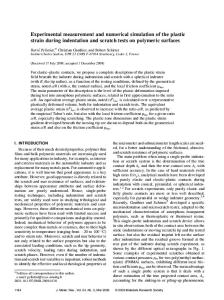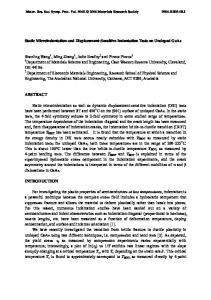Acoustic Emissions During Indentation Tests
- PDF / 398,625 Bytes
- 6 Pages / 420.48 x 639 pts Page_size
- 97 Downloads / 394 Views
ACOUSTIC EMISSIONS DURING INDENTATION TESTS T P Weihs*, C W Lawrence*, B Derby*, C B Scruby** and J B Pethica* *Department of Materials, Parks Rd, Oxford, OXI 3PH, UK **also at National NDT Centre, AEA Technology, Harwell Laboratory, UK
ABSTRACT When a hard tip ixdents a sample, cracking, delamination and plasticity can all produce acoustic signals in the form of elastic waves. This paper describes how these acoustic emissions (AE) can be monitored using piezoelectric elements and a load-controlled indentation instrument. Signals emitted from thin films and bulk materials are shown and they are correlated with distinct jumps in displacement of the indenter tip. The benefits and difficulties of different methods of monitoring the emissions are also considered. INTRODUCTION The technique of acoustic emission has been used as a non-destructive means for monitoring both fracture and plastic deformation in materials [1]. As a crack grows or dislocations glide in a sample, energy can be dissipated in the form of elastic waves. These waves are generated by sudden changes in stress and in displacement that accompany the deformation. If the release of energy is sufficiently large and rapid, then elastic waves in the ultrasonic frequency regime will be generated and it is possible to detect them using piezoelectric transducers. Typically, AE tests are performed on large, macroscopic specimens [1]. However, if one produces crack growth or dislocation motion using a Nanoindenter [2], then deformation can be localized to volumes less than 1000 11m 3 . In this case, the AE signals that are recorded can be correlated with the motion of particular defects. Furthermore, since the instrument is force controlled, it provides a rough measure of the changes in potential energy accompanying the growth of the defects. For example, as a crack extends suddenly under the applied indentation force, the indenter tip may jump sharply downwards. The product of this displacement and the applied force approximates the potential energy lost. The rate at which energy is released by the defect can be approximated by the rise time of the AE signal [1]. The faster the release, the smaller the rise time and the sharper the signal. During this initial study, the rate and energy of defect motion has been observed in a variety of systems. The formation of radial and lateral cracks in silicon and glass, the delamination of nickel films from substrates, the debonding of ceramic fibres and the generation and propagation of dislocations in single crystal tungsten have all been investigated. These studies will be presented and some of the benefits and difficulties of these tests will be reviewed. EXPERIMENTAL PROCEDURE All samples were indented with a high load Nanoindenter [2] and the acoustic emissions were measured using a commercial piezoelectric transducer and two Tektronix digital storage oscilloscopes connected in series (Figure 1). The new Nanoindenter, with its increased force capability of 10 N, offered the ability to monitor cracking and debonding
Data Loading...











